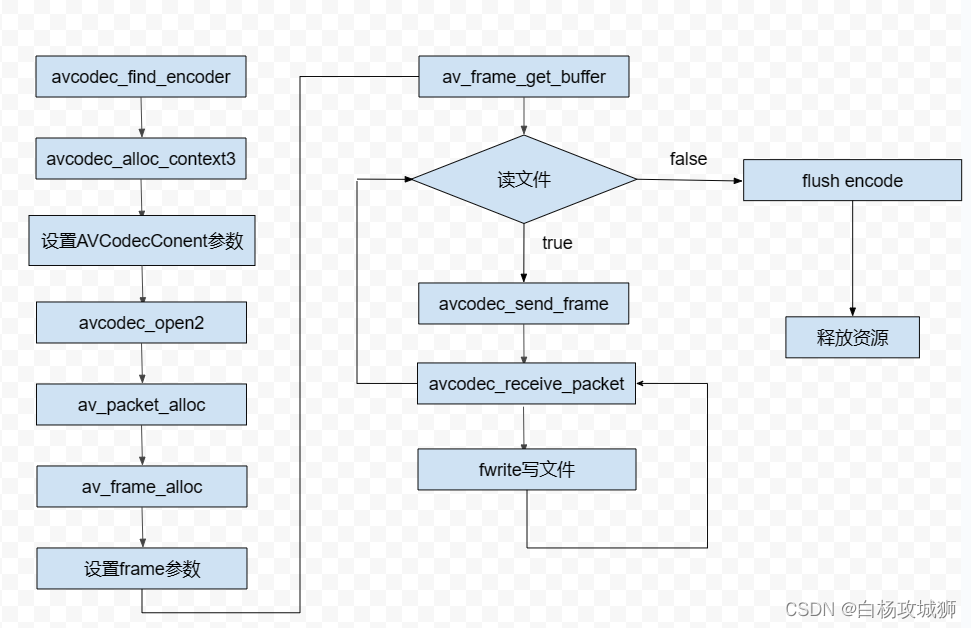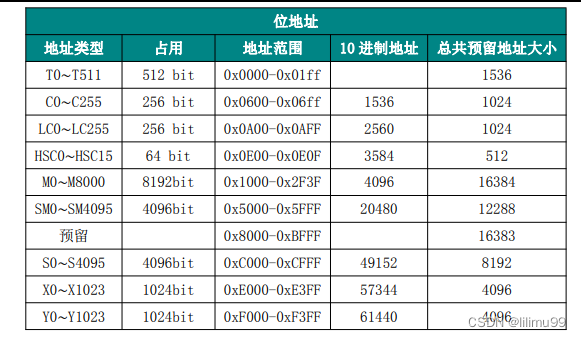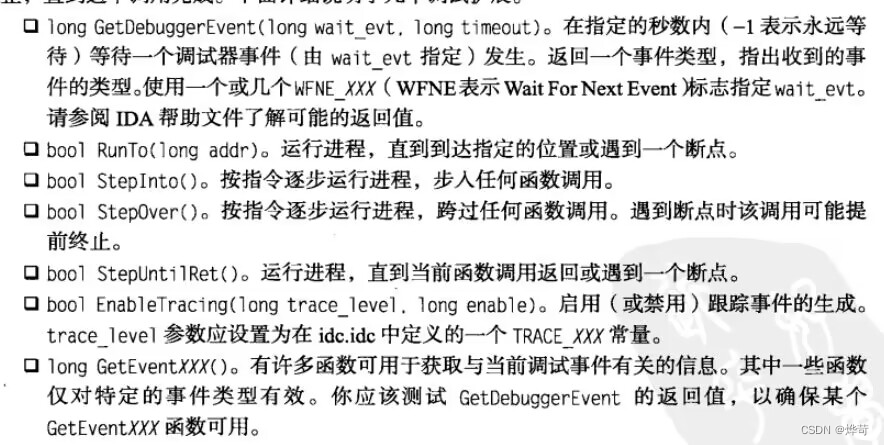准备
ffmpeg 4.4
p准备一段yuv420p的格式的视频原始数据
这里我们使用命令直接提取
ffmpeg -i .\beautlWorld.mp4 -pixel_format yuv420p -s 1280x720 yuv420p_1280x720.yuv
编码流程

大致可以分为以下几步:
1.初始化编码器并设置参数
2.初始化AVPacket和AVFrame,设置参数
3.读取视频文件,进行编码
4.释放内存,结束
编码
以下是完整代码
#include <stdio.h>
#include <stdlib.h>
#include <string.h>
extern "C"
{
#include <libavcodec/avcodec.h>
#include <libavutil/time.h>
#include <libavutil/opt.h>
#include <libavutil/imgutils.h>
}
using namespace std;
const char* inFileName = "D:/测试工程/sound/yuv420p_1280x720.yuv";
const char* outFileName = "D:/测试工程/sound/3333encode_yuv420p_1280x720.h264";
int encode(AVCodecContext* codecContent, AVPacket * packet, AVFrame* frame, FILE* outFile)
{
//解码
int ret = avcodec_send_frame(codecContent, frame);
if (ret < 0)
{
fprintf(stderr, "Error sending a frame for encoding\n");
return -1;
}
while (ret == 0)
{
ret = avcodec_receive_packet(codecContent, packet);
if (ret == AVERROR(EAGAIN) || ret == AVERROR_EOF) {
return 0;
}
else if (ret < 0) {
fprintf(stderr, "Error encoding video frame\n");
return -1;
}
if (ret == 0)
{
fwrite(packet->data, 1, packet->size, outFile);
}
}
}
int main(int argc, char* argv[])
{
int ret = 0;
AVCodec* codec = nullptr;
AVCodecContext* codecContent = nullptr;
AVPacket* packet = nullptr;
AVFrame* frame = nullptr;
FILE* inFile = nullptr;
FILE* outFile = nullptr;
//编码器初始化
codec = avcodec_find_encoder(AV_CODEC_ID_H264);
if (codec == nullptr)
{
printf("could not find h264 encoder!");
return -1;
}
codecContent = avcodec_alloc_context3(codec);
if (codecContent == nullptr)
{
printf("could not alloc h264 content!");
return -1;
}
//必设参数
codecContent->width = 1280;
codecContent->height = 720;
codecContent->time_base = AVRational{ 1, 25 };
codecContent->pix_fmt = AV_PIX_FMT_YUV420P;
codecContent->gop_size = 25; //关键帧间隔,默认250
codecContent->framerate = AVRational{ 25, 1 };
ret = avcodec_open2(codecContent, codec, NULL);
if (ret < 0) {
fprintf(stderr, "Could not open codec: %d\n", ret);
exit(1);
}
packet = av_packet_alloc();
if (packet == nullptr)
{
printf("alloc packet error");
return -1;
}
frame = av_frame_alloc();
if (packet == nullptr)
{
printf("alloc frame error");
return -1;
}
frame->width = codecContent->width;
frame->height = codecContent->height;
frame->format = codecContent->pix_fmt;
ret = av_frame_get_buffer(frame, 0);
if (ret)
{
printf("alloc frame buffer error!");
return -1;
}
inFile = fopen(inFileName, "rb");
if (inFile == nullptr)
{
printf("error to open file: %s\n", inFileName);
return -1;
}
outFile = fopen(outFileName, "wb");
if (inFile == nullptr)
{
printf("error to open file: %s\n", outFileName);
return -1;
}
int framecount = 0;
frame->pts = 0;
while (!feof(inFile))
{
ret = av_frame_is_writable(frame);
if (ret < 0)
{
ret = av_frame_make_writable(frame);
}
fread(frame->data[0], 1, frame->width * frame->height, inFile); //y
fread(frame->data[1], 1, frame->width * frame->height / 4, inFile); //u
fread(frame->data[2], 1, frame->width * frame->height / 4, inFile); //v
printf("encode frame num: %d\n", ++framecount);
frame->pts += 1000 / (codecContent->time_base.den / codecContent->time_base.num);
encode(codecContent, packet, frame, outFile);
}
encode(codecContent, packet, nullptr, outFile);
av_packet_free(&packet);
av_frame_free(&frame);
avcodec_free_context(&codecContent);
fclose(inFile);
fclose(outFile);
return 0;
}
小结
AVCodecContext
对于视频编码器而言必须设置以下参数:
AVRational time_base;
int width, height;
以下由用户设置,可选
gop_size: 默认250,也就是每250帧一个关键帧,可选设置
max_b_frames: 默认3, b帧最大连续个数
bit_rate: 平均比特率
avcodec_alloc_context3
AVCodecContext *avcodec_alloc_context3(const AVCodec *codec);
为AVCodecContext结构申请空间,并使用默认值初始化!最后使用avcodec_free_context进行释放。
avcodec_open2
int avcodec_open2(AVCodecContext *avctx, const AVCodec *codec, AVDictionary **options);
调用该函数前:time_base(也就是每帧显示的时间),width(帧宽), height(帧高)
av_frame_get_buffer
int av_frame_get_buffer(AVFrame *frame, int align);
为音视频分配数据存储空间。调用该函数前需要设置AVFRAME几个初始值。
音频:1.sample format 2.nb_samples 3.channel_layout
视频:1.pixel format 2.width 3.height
align:直接对其,默认给0,根据当前CPU自行设置



















